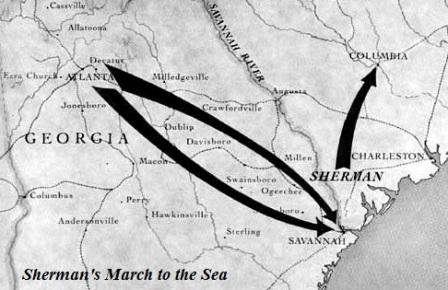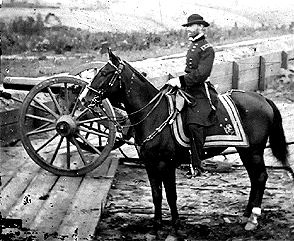| Sherman's March to the Sea |
|
| Summary of Sherman's March to the Sea
Summary: Sherman's March to the Sea, also called the Savannah Campaign, was undertaken by General William Tecumseh Sherman between November 12, 1864 and December 22, 1864. Sherman's March to the Sea was 285 miles long stretching from Atlanta to the Confederate coastal town of Savannah. Sherman left a path of destruction in his wake, exercising a "scorched earth policy" and wrecking the infrastructure, industries, crops and property in Georgia. Sherman's March to the Sea
Abraham Lincoln was the 16th American President who served in office from March 4, 1861 to April 15, 1865. One of the key events during his presidency was Sherman's March to the Sea during the Civil War. |
|
| | | Sherman's March to the Sea: Anaconda Plan
The Union devised a military strategy for the Civil War referred to as the Anaconda Plan. The objective of the Anaconda Plan was to to crush the life out of the Confederacy, the method used by the lethal anaconda snake to subdue their prey. At first it was a passive strategy devised to weaken the South without invading it. This changed to an aggressive strategy with Sherman's March to the Sea. William Tecumseh Sherman was arguably the greatest General in the Union army. He was determined, forceful and ruthless and believed that the way to victory in the Civil War was by breaking the spirit of the enemy. Sherman's March to the Sea was designed to achieve this and crush the spirit of the South. Facts about Sherman's March to the Sea: Atlanta
Sherman's March to the Sea followed the Union victory at the Battle of Atlanta after which Sherman ordered most of the buildings in the city to be burned, regardless or whether it was military or not. The next goal was the march through Georgia in the infamous Sherman's March to the Sea and his aggressive and destructive "scorched earth policy". | Map of Sherman's March to the Sea |
Sherman's March to the Sea: Grant agrees the Plan
William T. Sherman knew that the Confederacy was nearing defeat. He devised the plan to undertake a grand march through Georgia to the Savannah at the coast, and then march northward through the Carolinas up to to Virginia (see the Map). Sherman believed that such a march would destroy morale, demonstrate to the people of the South that further resistance was futile, and instill the belief that the Civil War was lost to the Confederacy. General Ulysses Grant agreed with Sherman's ideas, and told him to carry out his plans. Sherman's March to the Sea: Grant agrees the Plan
After leaving Atlanta, General William T. Sherman and some 60,000 of his soldiers headed toward Savannah, Georgia. The purpose of this Sherman's March to the Sea was to frighten Georgia’s civilian population into abandoning the Confederate cause. Sherman’s troops did not totally destroy any of the towns in their path, but they stole food and livestock and burned the houses, land and barns of people who tried to fight back.
Sherman's March to the Sea
Sherman's March to the Sea was undertaken between November 15 to December 10, 1864. Sherman had demonstrated his ruthlessness by destroying the mills and factories of Atlanta. Sherman and his army then set out for the sea, marching steadily through Georgia. He had 60,000 soldiers with him. His men were all veterans of bloody battles and marched towards the sea as if they were on a holiday. Spreading out over a line of 60 miles, they took everything that was edible. Along Sherman's March to the Sea they destroyed railroads. They pulled up the rails, heated them in the middle of fires made from burning railroad sleepers, and then twisted them around the nearest trees. They were nicknamed "Sherman's neckties". Sherman's men succeeded in cutting a gap 60 miles long in the railroad communication between the already half-starved Confederate Army of Northern Virginia and the destroyed the storehouses of southern Georgia. His battle-hardened, merciless men were totally ruthless in the destruction of the properties in the South, causing an estimated $100 million in damages. As they continued along Sherman's March to the Sea they adopted John Brown's Body Lies A-Mouldering in the Grave as their anthem. 
General William T. Sherman at Atlanta | Sherman's March to the Sea: The "scorched earth policy"
The Union Army employed the totally devastating "scorched earth policy" during Sherman's March to the Sea. A scorched earth policy is a military strategy that involves destroying anything that might be useful to the enemy, military or civilian, while advancing through an area. Sherman's March to the Sea inflicted significant damage to the industry, infrastructure, and civilian property of the South. His soldiers wrecked railroads, telegraph lines and bridges totally wrecking the infrastructure of the area. Sherman's March to the Sea: Confederate Opposition
The only opposition to Sherman's March to the Sea was Confederate cavalry under General Joseph Wheeler, the soldiers of William J. Hardee and various units of Georgia militia under Gustavus Smith. Confederacy opposition never exceeded more than 13,000 men. During Sherman's March to the Sea there were approximately 3100 casualties, of which 2,100 were Union soldiers. |
Sherman's March to the Sea: Savannah
On December 10, 1864, Sherman's March to the Sea finally ended and he turned his sights on the destruction of Savannah before he marched on to the Carolinas. Sherman’s troops arrived in the coastal town of Savannah on December 21, 1864. The city was undefended when they got there. The 10,000 Confederates soldiers who were supposed to be guarding Savannah had already fled. General William T. Sherman presented the city of Savannah to President Abraham Lincoln (1809-65) as a Christmas gift. Early in 1865, General William T. Sherman and his men left Savannah burning and pillaging their way through the Carolinas. The Civil War ended on April 9, 1865, when the Confederate commander in chief, General Robert E. Lee, surrendered to General Grant at Appomattox Courthouse, Virginia. |
Facts about the Sherman's March to the Sea
The following short fact sheet provides interesting facts and information about the Sherman's March to the Sea, one of the major campaigns that was fought during the American Civil War (April 12, 1861 - May 10, 1865). Sherman's March to the Sea: FAQ's (Frequently Asked Questions for kids) | | Facts for Kids | Questions and Answers | | Sherman's March to the Sea Fact 1 | Q. What was the Sherman's March to the Sea and example of in modern warfare?
A. Total War. The strategy of Total War employed by Sherman destroyed the resources, infrastructure, railroads, bridges and morale required for the South to continue to make war | | | | Sherman's March to the Sea Fact 2 | Q. When was the Sherman's March to the Sea?
Sherman's March to the Sea was between November 12, 1864 and December 22, 1864. | | | | Sherman's March to the Sea Fact 3 | Q. Who won the Sherman's March to the Sea?
A. It was a decisive victory for the Union. | | | | Sherman's March to the Sea Fact 4 | Q. Where did Sherman's March to the Sea begin and end?
A. Sherman's March to the Sea beagn in Atlanta and ended 235 miles away in Savannah | | | | Sherman's March to the Sea Fact 5 | Q. How many men fought in the Sherman's March to the Sea?
A. The strength of the Union force was 60,000. The number of Confederate soldiers totaled 13,000 | | | | Sherman's March to the Sea Fact 6 | Q. How many casualties were there?
A. There were 3100 casualties, of which 1000 were Confederates and 2,100 were Union soldiers. | | | Sherman's March to the Sea: FAQ's (Frequently Asked Questions for kids) |
Sherman's March to the Sea - President Abraham Lincoln Video
The article on the Sherman's March to the Sea provides an overview of one of the major issues of his presidential term in office. The following Abraham Lincoln video will give you additional important facts and dates about the political events experienced by the 16th American President whose presidency spanned from March 4, 1861 to April 15, 1865. | | |
| |
|